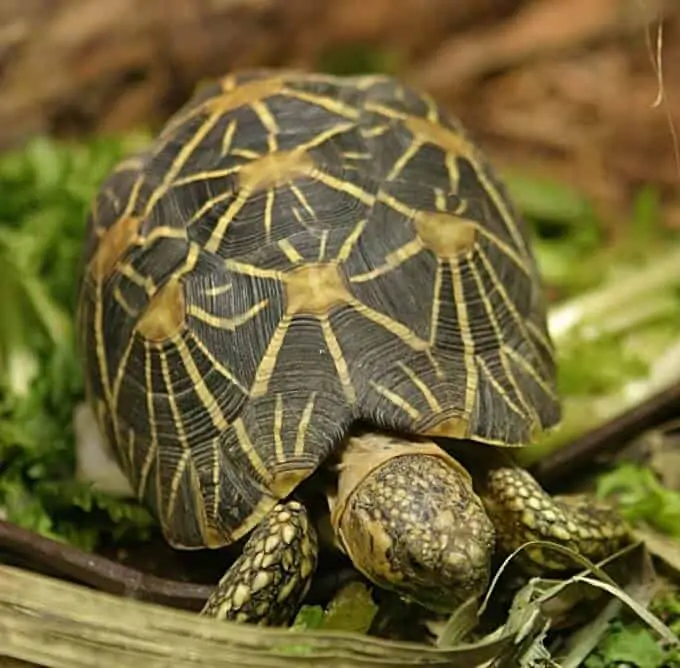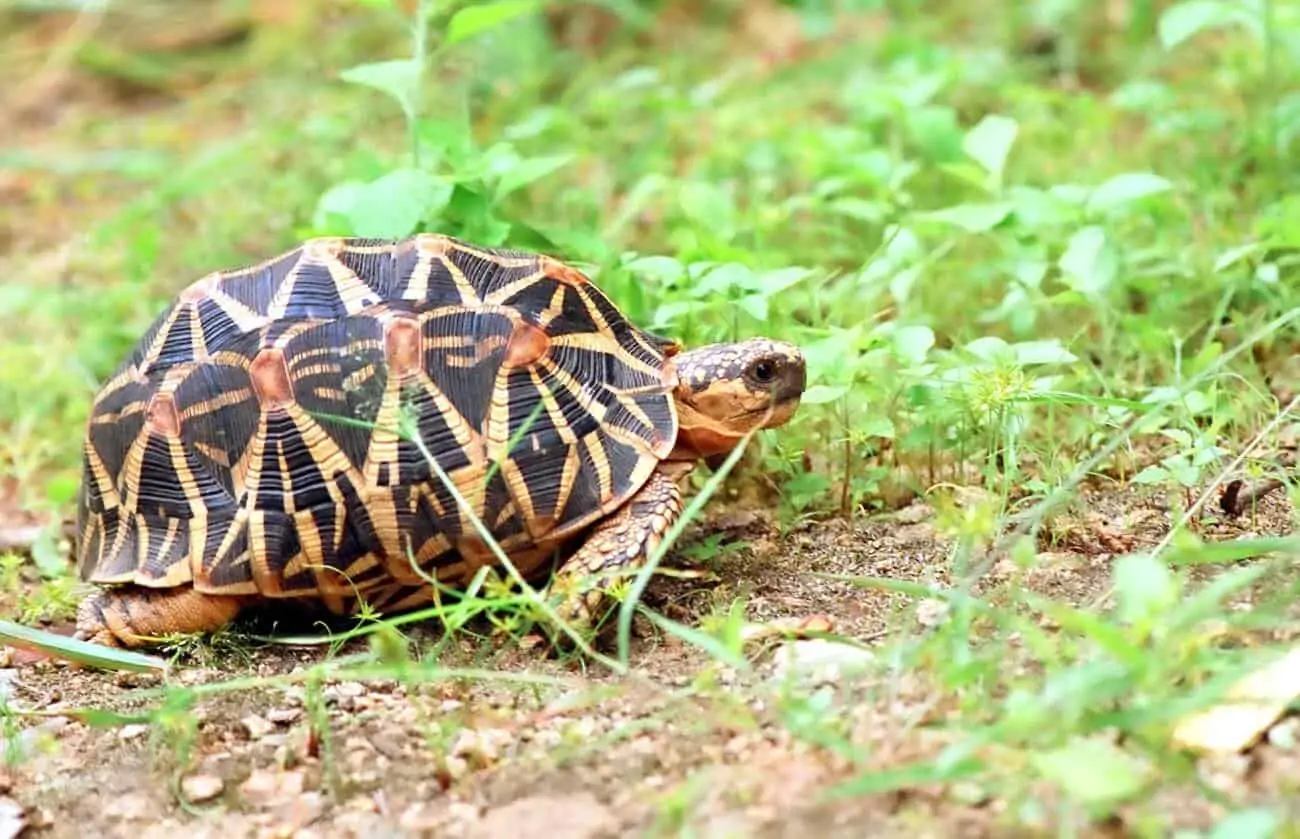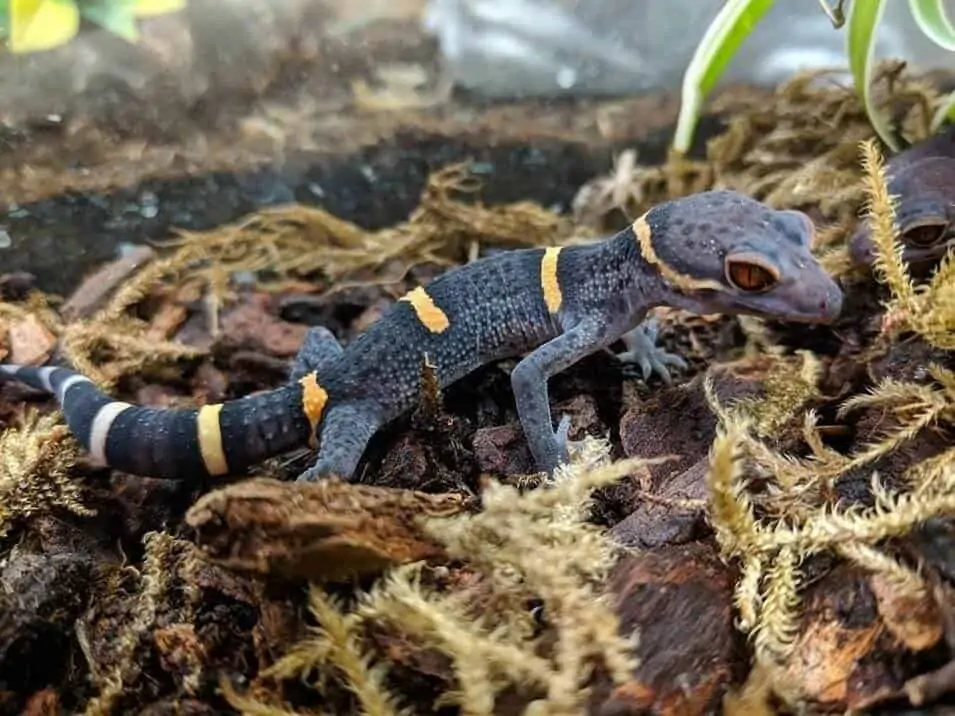Indian star tortoises are a very popular pet that we’ve been a fan of for a while. These reptiles are incredibly unique and offer a unique look that can’t be found elsewhere.
However, there are a few things you’ll need to know if you’re interested in getting one for yourself. These tortoises are not the easiest species to care for, so you have to be prepared ahead of time.
This guide will teach you the basics of Indian star tortoise care. Habitat setup, size, food, lifespan, and other facts are all included!
Table of Contents
Species Summary
There’s no denying the beauty of the Indian star tortoise. This species (scientifically known as Geochelone elegans) is one of the most sought-after in the reptile scene. Known for their gorgeous shell and docile nature, the tortoise is a favorite among collectors and hobbyists.
Unfortunately, the popularity of this species has led to the endangerment of wild populations. Luckily, the species is now protected, with local laws prohibiting exportation. Breeders have seen success as well, resulting in a healthy population of captive-bred tortoises to support the demand.
Indian star tortoises are endemic to regions of southern India, Sri Lanka, and Pakistan. Usually, it’s found in arid environments and brush forests, but it’s also comfortable in the heavy moisture of the monsoon season!
Appearance & Colors
The shell of the Indian star tortoise is broad and finely detailed. It’s comprised of several concentric scutes. Each scute is raised, creating a beautiful ridged appearance.

Surrounding the central scutes is an apron of smaller ones around the perimeter. Those scutes flare out slightly from the carapace for added protection.
The Indian star tortoise gets its name from the distinct pattern on the carapace. The base color of the shell is dark brown or black, and each scute is lined with bright yellow streaks.
The streaks radiate from the center, create a star-like pattern that’s undeniably beautiful.
On the bottom of the shell, these tortoises have a lighter-colored plastron. It’s usually devoid of the star pattern.
Expert Tip: For males, the plastron is concave. Meanwhile, females have a flat plastron.
The body of the tortoise is equally stunning. The head, tail, and legs are all covered in protective tan scales. The head is relatively smooth, but it features a hooked beak for breaking down food.
Indian Star Tortoise Size
The average size of an Indian star tortoise is between seven and 12 inches.
With that being said, size can vary based on gender and what area the tortoise is native to. For example, those from mainland India tend to be slightly bigger than those with ancestral roots in Sri Lanka or Pakistan.
Expert Tip: Females are always the larger of the sexes. Females will typically grow a good two to three inches longer than males, making them easy to distinguish.
Lifespan
The typical Indian star tortoise lifespan is between 30 and 55 years. Like other tortoise species, Indian stars are capable of outliving their owners! If you’re lucky, you may see your reptile live up to 55 years or longer.
It’s even said that these tortoises can live to be up to 80 years old. However, there are no reliable reports about captive tortoises living that long.
As always, there are no guarantees when it comes to lifespan. This is especially true with a species as sensitive to disease as the Indian Star.
You can do your part to help them live as long as possible. Keep up with their needs and dedicate time to caring for these reptiles. If you don’t, your pet could suffer from disease and an early death.
Indian Star Tortoise Care
Indian star tortoise care is not for novice reptile-keepers. This is a sensitive species that requires a lot of time and dedication to keep healthy. You may be spending upwards of 45 minutes to an hour every day with husbandry tasks!
Caring for this tortoise isn’t complicated, per se. However, there are many factors that you have to stay on top of.
Below are some established care guidelines you can follow:
Enclosure Size
You have a couple of options for the enclosure. If you plan on keeping your tortoise inside, a standard turtle table or reptile terrarium works well.
We recommend keeping a single tortoise in a terrarium that’s at least 50 gallons in volume. Make sure that the enclosure features at least one screened side (adjustable vents are suitable as well).
If you live in a warm climate, you can keep the Indian star tortoise in an outdoor aquarium. A small group can live comfortably in a habitat that measures about six feet long by six feet wide.
Indian star tortoises aren’t big climbers or strong burrowers, so the height of the enclosure’s fences only need to be tall enough to block the reptile’s view.
Expert Tip: Don’t forget to consider any local predators your tortoises might need protection from as well. A screened top for your outdoor enclosure may be necessary.
Habitat Setup
Indian star tortoises aren’t too demanding when it comes to decor. The key is to choose items that support the environment of the enclosure while also providing some enrichment for your reptile.

It’s important to start with a thick layer of substrate.
Absorbing substrates like organic potting soil, peat moss, coconut coir, or even live grass work well. All of those substrate materials hold onto moisture, which is great for raising humidity levels.
Beyond that, you can introduce some live plants into the mix. Your tortoise may snack on the plants from time to time, so choose healthy varieties. Bermuda grass, fountain grass, and hay are all worthy choices.
Rocks and other decorative items aren’t necessary, but you can add them to create a more natural appearance.
Another thing you’ll definitely need is a hide box. Indian star tortoises are very shy. Having a large enclosure for them to scurry into can provide an additional layer of comfort for the tortoise.
Temperature & Lighting
The Indian star tortoise is a cold-blooded creature that thermoregulates its body temperature. This process is pretty autonomous, but these pet tortoises need a proper temperature gradient inside their enclosure to stay comfortable.
On one side, use a basking lamp to raise temperatures around 95 degrees Fahrenheit. The basking spot should remain between 90 and 95 degrees throughout the day.
On the cooler end, temperatures in the mid-80s are preferred.
Expert Tip: Indian stars can tolerate a temperature drop of about 10 degrees at night. However, you can’t let the ambient temperatures fall below 70 degrees. This applies to both outdoor and indoor locations.
Consider installing a heat emitter, or under-tank heating pad to raise temperatures to a safe level at night.
Finally, you’ll need a UVB lamp. UVB lighting is only necessary if you keep the tortoise indoors, since outdoor reptiles will get their UV rays naturally from the sun.
Install a 10-percent UVB lamp and make sure it covers the entire tank. Put in on a timer to ensure that your tortoise is getting 8 to 12 hours of exposure every day.
Humidity
Indian star tortoises require a very high level of relative humidity. The enclosure should have humidity levels around 80 percent throughout the day.
This is one of the trickier parts of keeping this species. Use a hygrometer and check the habitat regularly. You might have to make adjustments to the vents to keep moist air in. Daily mistings are often necessary, too.
To make things easier, you could install an automatic mister or dripper. This isn’t a requirement, but some owners like them due to the time they save.
Using the right substrate in their habitat will impact humidity regulation as well. The substrate will do a lot to slow down water evaporation to keep things nice and humid.
Water
The final thing you need in the terrarium is a water bowl. Indian star tortoises don’t really drink from containers, but the bowl will serve many other purposes. It will help with humidity, thermoregulation, and more.
Choose a large water container that’s big enough for the tortoise to climb in. A sloped bottom is always preferred to ensure that your tortoise can get in and out.
Always make sure the bowl is full of clean water. The tortoise may defecate in it, so monitor it closely and replenish the water whenever necessary.
Food & Diet
Indian star tortoises are natural foragers. They are herbivores by nature and will eat a wide range of plant-based foods.
The important thing with creating meals is to provide enough nutritional balance. Mix things up and try to include as many leafy greens as possible. You want to make sure that your tortoise is getting all the vitamins and nutrients they need.
You may also want to consider adding multivitamin supplements and calcium powders into the mix for good measure.
Provide enough food that your tortoise can eat in 15 to 30 minutes. Feed them daily and add as much variety to their meals as possible.
Here are some good plant-based foods to try out:
- Romaine lettuce
- Bermuda grass
- Alfalfa
- Mustard greens
- Timothy hay
- Kale
- Orchard grass
- Endive
- Dandelion greens
- Parsley
- Cactus leaves
- Escarole
- Rye grass
Expert Tip: Avoid foods that are high in oxalates. This includes spinach, cabbage, or broccoli. They can prevent proper calcium synthesis. Fruits should be avoided, too, as they’re prone to cause digestion problems.
Potential Health Issues
Unfortunately, the Indian star tortoise is prone to disease. They’re a bit more sensitive than other reptiles, so you have to work harder to keep the environment in good shape.
The most common ailment you’ll have to deal with is respiratory infections. These infections can cause inflammation and discharge around the nostrils, eyes, and mouth.
Respiratory infections are usually a product of low humidity levels or improper temperature. Unsanitary conditions can cause infections as well.

Like we said earlier, invest in accurate temperature and humidity gauges. A hygrometer will eliminate second-guessing. Also, clean the habitat regularly!
Spot clean the enclosure every day. About once a month, do a deep clean. Sanitize every surface to ensure that bacteria doesn’t become a problem.
Another common health problem with this tortoise is metabolic bone disease. This is something that can affect all reptiles. Reptiles rely on UVB exposure to synthesize calcium. Without it, the body isn’t able to use the calcium they get from their meals.
As a result, the bones become brittle and weak. This is a particularly nasty problem for the Indian Star. It can lead to shell disease. Holes and cracks can form, putting the tortoise at serious risk for other health concerns.
Make sure the UVB lamp you use works well! Remember to change the bulb every six months or so. You can’t see the UVB light, so many owners fail to swap it out once it stops working.
Behavior & Temperament
Indian star tortoises are naturally shy. They can get a bit more comfortable once they get used to their surroundings. However, these reptiles are never going to enjoy handling or being around other animals.
The only exception to this rule is other Indian star tortoises. Interestingly enough, this species isn’t territorial. They have no problem sharing space with others. This even applies to males!
As a result, you can keep multiple Indian star tortoises together without any issues.
Most tortoises will bask or rest throughout the day. You might see them foraging for food and snacking on plants in the habitat. They’re not climbers or diggers, so you don’t have to worry too much about escape attempts. As long as the enclosure is well-secured, they’ll live happily in it.
Handling Them
The Indian star tortoise is not a pet that you want to handle all the time. Simply put, these reptiles don’t like it. In fact, too much handling can lead to increased stress levels and even a higher chance of encountering disease.
The occasional handling is fine. However, you should limit it to when you need to clean the tank. Move them to a separate habitat and try to put them down as soon as possible.
Conclusion
Even though Indian star tortoise care isn’t the easiest thing in the world, these reptiles are definitely worth the effort (as long as you’re prepared).
Their beautiful look is something you can’t find anywhere else, and they’ll never cease to be a source of entertainment and appreciation. Not only that, but their long lifespan allows you to build quite the bond over time!
Let us know if there’s anything else you’d like us to cover in this care guide. We’re always open to making tweaks and improvements.



